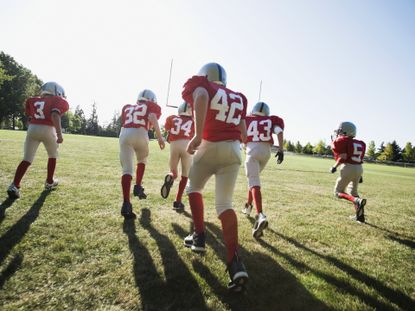How do you solve a problem like concussions in youth sports?
Researchers are working on some impressive innovations. But cost and awareness are still big issues.


In a recent provocative New York Times opinion piece, a doctor urged parents, coaches, and physicians to stop kids from playing football.
"Our children are minors who have not reached the age of consent," wrote Dr. Bennet Omalu, warning of the risk of irreversible brain damage. "It is our moral duty as a society to protect the most vulnerable of us."
Omalu is the doctor who first published findings on chronic traumatic encephalopathy in football players, the disease linked to depression and memory loss that was posthumously found to have affected Junior Seau, Frank Gifford, and other NFL athletes subjected to repetitive brain trauma. Still, the notion that kids should stay away from football — or from any contact sport — entirely due to the risk of CTE is considered extreme even among those who do concussion research.
Subscribe to The Week
Escape your echo chamber. Get the facts behind the news, plus analysis from multiple perspectives.

Sign up for The Week's Free Newsletters
From our morning news briefing to a weekly Good News Newsletter, get the best of The Week delivered directly to your inbox.
From our morning news briefing to a weekly Good News Newsletter, get the best of The Week delivered directly to your inbox.
"I think to just come out and say we should just not allow kids to play football isn't something that's a very practical statement, whether you believe what he's saying or not," said Dr. Samuel Browd, a University of Washington-affiliated neurosurgeon. "What you want to do is try to make the sport as safe as humanly possible."
That's where innovation comes in. Researchers still don't know with certainty if or how concussions are linked to CTE — in professional football, or at any level in any sport, for that matter. That means it's practical for many experts to focus on finding new ways to help athletes, physicians, and coaches monitor and prevent concussions.
Making sports safe for youth athletes isn't easy. Public discourse often focuses on professional football players. That in itself is an important area for improvement in concussion prevention. Indeed, consider that fewer than 2,000 professional football players are rostered at any given time during the regular season. Now compare that to the more than 26 million kids ages 6 to 17 who played youth sports in 2014, and the scope of people who stand to be helped by innovations in concussion-related technology becomes more clear.
In youth football, helmets are one of the most promising areas for innovation. Browd co-founded VICIS, a company through which scientists, neurosurgeons, and engineers designed a football helmet structured to prevent more concussions by absorbing more force before it can reach the player.
Sign up for Today's Best Articles in your inbox
A free daily email with the biggest news stories of the day – and the best features from TheWeek.com
VICIS, which has received multiple rounds of funding from an NFL-backed initiative, is shooting to launch the helmets in early 2016, first by targeting professional and top-tier NCAA teams. But the ultimate goal, Browd said, is to get younger athletes on board.
New football helmet designs are an important step in preventing concussions, but they can only go so far toward helping kids. Athletes across many sports, like hockey, rugby, wrestling, and soccer, need answers, too.
"[Helmets are] not going to work for everybody," said Steven Broglio, director of a University of Michigan concussion research lab. "People doing backstroke occasionally hit their head against the wall. You're going to put a helmet on a swimmer? It just doesn't make sense. Maybe we pad the walls. Maybe that's the answer to it. People want to put these draconian measures in place. Things just don't work that way."
Another innovative option for athletes is accelerometers, which monitor the impact players absorb and log that data for players, athletic trainers, and physicians to reference. Some sensors go inside helmets, but others are designed as mouth guards or earpieces. The technology is meant to flag potential concussions, as opposed to preventing them from happening in the first place. But the accuracy of the gear is up for debate.
"Technology will ultimately become a very important part of managing players and understanding the dynamics of the hit," Browd said. "The science has yet to even catch up to the technology. We don't know if a hit with a certain amount of force is going to lead to a concussion."
Cost is an issue, too. Riddell's Head Impact Telemetry System, a popular sensor used in football, may cost a high school $65,000 to implement, Broglio estimated.
"We look at something like a HIT System, which would probably cost you $65,000 to equip the team," he said. "There's a lot of schools now where it's pay to play. They're sure as heck not going to buy a HIT System."
A more practical alternative, Broglio suggested, might be spending money to hire a full-time athletic trainer, something only 37 percent of public secondary schools have, according to a 2015 Journal of Athletic Training study. Plus, athletic trainers don't only help with concussions — they're also a resource for players facing dehydration, broken bones, and other issues.
There's no one easy solution that would eliminate concussion risks for youth athletes. But advancements in technology, when combined with continued research and public education, have the potential to assuage safety concerns and keep players in the game.
"We want them outside," Browd said, "and we want them playing and exercising."
Julie Kliegman is a freelance writer based in New York. Her work has appeared in BuzzFeed, Vox, Mental Floss, Paste, the Tampa Bay Times and PolitiFact. Her cats can do somersaults.
-
 Greenland is hoping to boost tourism with the Arctic's first international airport
Greenland is hoping to boost tourism with the Arctic's first international airportIn the Spotlight The enhanced facility is the first international airport in Greenland's capital
By Justin Klawans, The Week US Published
-
 Sudoku medium: December 10, 2024
Sudoku medium: December 10, 2024The Week's daily medium sudoku puzzle
By The Week Staff Published
-
 Codeword: December 10, 2024
Codeword: December 10, 2024The Week's daily codeword puzzle
By The Week Staff Published